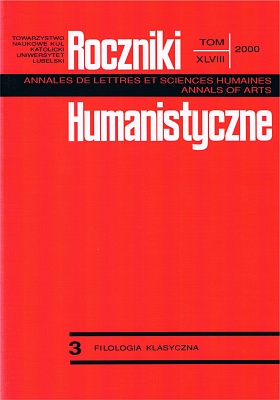Walencja semantyczna a walencja syntaktyczna na przykładzie łacińskich czasowników emere, admonere i aestimare
Abstrakt
The aim of the present article has been to show on the example of the three Latin verbs – emere, admonere and aestimare – the relations occurring between valency on the semantic plane and valency on the syntactic plane. Analysis of the syntactic valency of the verbs and of their semantic valency expressed in terms of deep cases confirms the thesis that there is no univocal correspondence between valency on the semantic plane and valency on the syntactic plane. On its basis it may be said that the same semantic case is realized in a different way as the actant of the surface structure, and in turn actants that are the same as far as their morphological form is concerned have different semantic roles.
Bibliografia
Apresjan J. D.: Leksičeskaja semantika. Sinonimičeskie sredstva jazyka. Moskva 1974; tłum. pol.: Semantyka leksykalna. Synonimiczne środki języka. Przeł. Z. Kozłowska i A. Markowski. Wrocław 1980.
Bondzio W.: Valenz, Bedeutung und Satzmodelle. W: Beiträge zur Valenztheorie. The Hague 1971 s. 84-104.
Brinker K.: Modelle und Methoden der strukturalistischen Syntax. Eine Einführung. Stuttgart 1977.
Buttler D.: Innowacje składniowe współczesnej polszczyzny. Walencja wyrazów. Warszawa 1976.
Bühler K.: Sprachtheorie. Die Darstellungsfunktion der Sprache. Jena 1934.
Encyklopedia językoznawstwa ogólnego. Red. K. Polański. Wrocław 1993.
Fillmore Ch.: The Case for Case. W: E. Bach, R.T. Harms (eds.). Universals in Linguistic Theory. New York 1969 s. 1-88.
Fillmore Ch.: Some Problems for Case Grammar. W: R. S. O'Brien, S. J. O'Brien (eds.). Report of the Twenty-Second Annual Round Table Meeting on Linguistics and Language Studies. Washington 1972 s.35-56.
Fisiak J.: Wstęp do współczesnych teorii lingwistycznych. Warszawa 1975.
Flämig W.: Valenztheorie und Schulgrammatik. W: Beiträge zur Valenztheorie. The Hague 1971 s. 105-121.
Helbig G.: Entwicklung der Sprachwissenschaft seit 1970. Leipzig 1986.
Helbig G.: Valenz und Lexikographie. „Deutsch als Fremdsprache” 20:1983 z.3 s.137-143.
Helbig G.: Valenz und Sprachebenen. „Zeitschrift für Germanistik” 3:1982 z.1 s.69-84.
Helbig G.: Valenz und Tiefenstruktur. „Deutsch als Fremdsprache” 6:1969 z.3 s.159-169.
Helbig G.: Zum Status der Valenz und der semantischen Kasus. „Deutsch als Fremdsprache” 16:1979 z.2 s.65-78.
Helbig G.: Zur Valenz verschiedener Wortklassen. „Deutsch als Fremdsprache” 13:1976 z.3 s.131-146.
Helbig G., Schenkel W.: Wörterbuch zur Valenz und Distribution deutscher Verben. 2. Aufl. Leipzig 1973.
Karolak S.: Zagadnienia składni ogólnej. Warszawa 1972.
Nikula H.: Verbvalenz. Untersuchung am Beispiel des deutschen Verbs mit einer kontrastiven Analyse Deutsch-Schwedisch. Uppsala 1976.
Porzig G.: Das Wunder der Sprache. W: Probleme, Methoden und Ergebnisse der modernen Sprachwissenschaft. München 1950.
Porzig G.: Wesenhafte Bedeutungsbeziehungen. „Beiträge zur Geschichte der deutschen Sprache und Literatur” 58:1934.
Rosengren B.: Status und Funktion der tifenstruktuellen Kasus. W: Beiträge zu Problemen der Satzglieder. Leipzig 1978.
Saussure F. de: Cours de linguistique générale. Genève 1916; tłum. pol.: Kurs językoznawstwa ogólnego. Przeł. K. Kasprzyk. Warszawa 1961.
Smereka K.: Valenztheorie und Sprachvergleich im Bereich ausgewählter Verbfelder des Deutschen und Polnischen. „Acta Universitatis Wratislaviensis” 696. Wrocław 1986.
Welke K. M.: Einführung in die Valenz- und Kasustheorie. Leipzig Bibliografisches Institut, 1988.
Zarębina M.: Elipsa a konotacja. „Biuletyn PTJ” 25:1967 s. 111-121.
Zaron Z.: Niektóre problemy z konotacją syntaktyczną. W: Konotacja. Praca zbiorowa pod red. J. Bartmińskiego. Lublin 1988 s.113-119.
Copyright (c) 2000 Roczniki Humanistyczne

Utwór dostępny jest na licencji Creative Commons Uznanie autorstwa – Użycie niekomercyjne – Bez utworów zależnych 4.0 Międzynarodowe.





